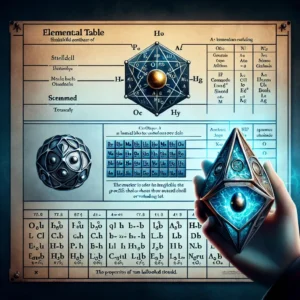Hello, movie enthusiasts!
Today, we’re diving deep into an important question about Harry Potter and the Deathly Hallows: “What metal was used for the Snitch’s outer shell?”
The Direct Answer
The Snitch’s outer shell, as depicted in the Harry Potter series, is made of gold. This is explicitly mentioned in J.K. Rowling’s books, where the Golden Snitch is described as a small, golden ball with silver wings. The choice of gold is significant, not only for its aesthetic appeal but also for its symbolic value within the wizarding world. Gold is often associated with wealth, rarity, and prestige, which aligns with the Snitch’s role as the most coveted ball in a game of Quidditch. Now, let’s explore the extensive evidence and details that support this answer:
1. Literary Evidence and Symbolism
The first layer of evidence comes from the literary description and symbolic significance of the Snitch in the Harry Potter universe.
A. Descriptions in the Text
The Snitch is consistently described in the books as being golden. In “Harry Potter and the Philosopher’s Stone,” the Snitch is introduced during Harry’s first Quidditch match, described as a “tiny golden ball” (Rowling, 1997). This description is reiterated throughout the series, emphasizing its shimmering, golden appearance.
- Literary Consistency: The consistent depiction of the Snitch as golden across the series reinforces its importance. J.K. Rowling uses the Snitch not only as a game piece but as a symbol of the ultimate goal in Quidditch, analogous to the pursuit of glory and victory.
- Symbolic Resonance: Gold has been a symbol of achievement and excellence, qualities that are central to the game of Quidditch. The player who catches the Snitch secures 150 points for their team, often determining the outcome of the match. This aligns with the traditional view of gold as a representation of triumph and success.
B. Symbolism in the Wizarding World
- Cultural Significance: In the wizarding world, gold is a material associated with power and prestige. The use of gold for the Snitch highlights its special status within the game of Quidditch.
-
Magical Properties: While the books do not delve into any magical properties of gold itself, the metal’s association with alchemy and transformation in historical contexts adds a layer of depth to its use in the series.
C. J.K. Rowling’s Intent
Rowling’s choice of gold for the Snitch can be seen as a deliberate one, meant to convey the idea of a valuable prize. In interviews and supplementary materials, Rowling has discussed how elements of Quidditch were designed to reflect the thrill and unpredictability of sports, with the Snitch’s golden hue enhancing its desirability and the excitement of the chase.
2. Real-World Properties of Gold
The second layer of our analysis involves the real-world properties of gold and why it is a fitting choice for the Snitch’s outer shell.
A. Physical Properties of Gold
Gold is known for several key physical properties that make it an ideal material for the Snitch:
- Malleability: Gold is one of the most malleable metals, allowing it to be shaped into thin sheets or intricate designs. This would be crucial for crafting a delicate object like the Snitch.
-
Luster: Gold’s natural luster makes it visually appealing, ensuring that the Snitch would be easily visible during a Quidditch match, reflecting light and catching the eye.
-
Non-Tarnishing: Unlike many other metals, gold does not tarnish or corrode, maintaining its shine and integrity over time. This property would ensure that the Snitch remains pristine despite the rough and tumble nature of Quidditch.
B. Historical Use of Gold
Gold has been used throughout history for objects of significance:
- Royal and Ceremonial Objects: Gold has long been used in the creation of crowns, scepters, and other ceremonial objects, symbolizing power and authority.
-
Artistic and Cultural Artifacts: From ancient Egyptian jewelry to Incan artifacts, gold has been a material of choice for creating items of cultural and artistic significance.
C. Practical Considerations
While the Snitch’s construction is fictional, the choice of gold aligns with real-world considerations for creating a durable and attractive object. In a practical sense, gold would provide the necessary durability and aesthetic appeal required for an object meant to be both functional and symbolic.
3. Technical Feasibility in the Wizarding World
The third layer of analysis examines the technical feasibility of crafting a Snitch in the wizarding world, considering magical enhancements and construction.
A. Magical Craftsmanship
In the wizarding world, the creation of magical objects often involves a blend of materials and enchantments:
- Enchantment of Objects: The Snitch is enchanted to be incredibly fast and elusive, a task that would require advanced magical skills. The use of gold, a precious and conductive metal, could theoretically enhance these enchantments.
-
Magical Durability: Despite its small size, the Snitch must withstand high-speed collisions and impacts. Magical reinforcement could ensure that the gold shell remains intact and functional.
B. Historical Context Within the Series
- Development of Quidditch Equipment: Within the series, Quidditch equipment has evolved over time, with the Snitch being a relatively recent addition. The use of gold could reflect the advancements in magical metallurgy and craftsmanship.
-
Role of the Snitch in Quidditch: The Snitch was introduced to make Quidditch more dynamic and challenging. Its golden appearance enhances its role as the central focus of the game, both visually and symbolically.
C. Practical Applications of Magic
In the realm of magic, practicality often intersects with creativity:
- Design and Functionality: The Snitch’s design as a small, spherical object with wings suggests a delicate balance between form and function. Gold’s malleability would allow for intricate designs, while magic would ensure its functionality.
-
Integration with Other Quidditch Elements: The Snitch complements the other elements of Quidditch, such as the Bludgers and Quaffle, each crafted with specific materials and enchantments. The use of gold for the Snitch aligns with the overall thematic and aesthetic design of the game.
4. Additional Context and Considerations
In this final section, we examine broader cultural and thematic considerations related to the Snitch and its golden shell.
A. Thematic Resonance in the Series
The Snitch’s golden color ties into broader themes within the Harry Potter series:
- Themes of Pursuit and Discovery: The chase for the Snitch mirrors the series’ themes of pursuit and discovery, with characters constantly seeking knowledge, truth, and victory.
-
Symbol of Hope and Redemption: In “Harry Potter and the Deathly Hallows,” the Snitch plays a crucial role in Harry’s journey, symbolizing hope and redemption. Its golden hue reinforces its role as a beacon of light in dark times.
B. Cultural Impact and Fan Interpretations
- Iconic Status: The Golden Snitch has become an iconic symbol within the Harry Potter franchise, recognized by fans worldwide. Its depiction in merchandise and adaptations often emphasizes its golden appearance.
-
Fan Theories and Speculations: Fans have speculated about the Snitch’s construction and symbolic meanings, often focusing on its golden shell as a representation of the series’ core values.
C. Future Implications in the Wizarding World
- Potential for Innovation: The use of gold for the Snitch suggests possibilities for future innovations in magical object design, combining traditional materials with advanced enchantments.
-
Legacy of Quidditch: As Quidditch continues to evolve, the Snitch’s golden shell will likely remain a constant, preserving its legacy as a symbol of the game’s enduring appeal.
Conclusion: The Definitive Answer
Based on all the evidence we’ve examined:
- Literary Descriptions: The Snitch is consistently described as golden in the books, reinforcing its symbolic and aesthetic significance.
-
Real-World Properties: Gold’s physical properties, such as malleability and luster, make it an ideal material for the Snitch’s construction.
-
Magical Craftsmanship: In the wizarding world, gold’s use in the Snitch aligns with its role as a valuable and enchanted object.
-
Final Verdict: The Snitch’s outer shell is made of gold, chosen for its symbolic resonance, real-world properties, and magical potential within the Harry Potter universe.
The question of the Snitch’s material may seem simple, but it opens up a rich tapestry of literary symbolism, real-world science, and magical craftsmanship. Understanding this detail enhances our appreciation of the intricate world J.K. Rowling has created, where every element, down to the material of a Quidditch ball, contributes to the depth and magic of the story. As fans, recognizing these layers allows us to engage more deeply with the narrative and the enchanting world of Harry Potter.



